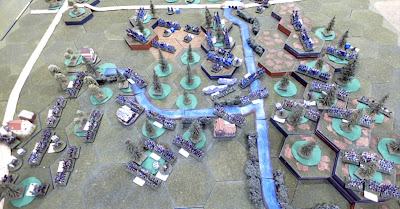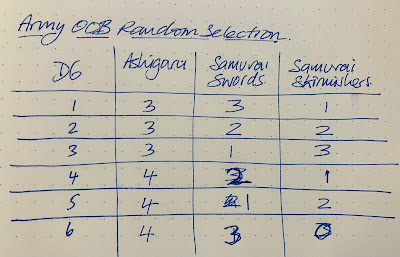During the past week, I had the fortunate opportunity to play in a remote American Civil War wargame. The game was organised and hosted by Jon of Palouse Wargaming Journal.
 |
| A close up of the action and Jon’s wonderful ACW collection. |
Jon had devised a scenario based upon Hood’s attack at 5pm during the Battle of Gettysburg on July 2, 1863. Prior to the game, Jon had provided a detailed briefing outlining the Federal forces but provided limited information about the Confederate forces. I am not overly familiar with the battle, so this provided some “Fog of War” level to the game for me.
 |
| An overview of the positions |
In the game, I had Hazlett's Battery and Weed's Brigade in reserve and they were to arrive from the north-east via the Millerstown Road. The exact timing of their arrival would be determined by a roll of the dice.
The primary objectives set for the Federal forces in the game were to hold Houck's Ridge and Little Round Top, ensuring that no Confederate troops were present on Millerstown Road to the east of Stony Hill by the conclusion of 6 turns.
My plans were to maintain a defensive along the objectives and positioning the Federal forces in the best defensive locations if possible, which generally meant in wooded areas.
On to the game…
 |
| The opening positions on the tabletop |
Turn 1
During the opening moves, I had originally thought the Confederates might make a concerted effort to attack against the Federal right flank, with the aim to outflank the position and gain access to the road. However, the opening Confederate attacks were concentrated on Houck's Ridge and Little Round Top, which were the key objectives of the game.
 |
| Turn 1 - the defensive line is established. |
Turn 2
Following the initial attacks, a few of which were turned back thanks to some favourable circumstances (dice rolls) my defensive line appeared quite solid. The right flank, in particular, was holding out very well and putting up strong resistance. Notably, my sharpshooters positioned in Devil's Den effectively repulsed an enemy charge - a significant accomplishment.
 |
| Turn 2 - The defensive line is holding |
Turn 3
The absence of available reserves was becoming a source of concern for me, particularly as Confederate forces were able to capture Devil's Den and had intensifying their attacks against my brigade stationed at Little Round Top. The fierce fighting was claiming brigade commanders on both sides as casualties, as they urged their forces forward or rallied their units in defence.
 |
| Turn 3 - The defensive line was under pressure in the centre and definitely under threat on the left flank. |
Turn 4
At last, the reinforcements arrived just as my defensive line had been breached. A couple of Confederate regiments had managed to infiltrate to my rear, while the remaining units were making a frantic effort to maintain their positions. The lack of brigade commanders, all of whom were casualties by now, meant saving hits was less effective.
 |
| Turn 4 - The defensive line is broken just as reinforcements arrive. |
Turn 5
The reinforcements swiftly advanced and successfully eliminated the Confederate units that had managed to penetrate the defensive line. The position on Little Round Top was promptly bolstered with fresh units. Nevertheless, the losses on my initial brigades ultimately overwhelmed their resolve, leading to their collapse and necessitating a general withdrawal of the Federal forces. A Confederate win.
Congratulations to Jon for hopefully a hard earned victory.
 |
| Turn 5 - The defensive lines started to stabilise, but too may brigades were broken and the positions would be vacated. |
Summary
Could my Federal forces have maintained their defensive position if the reserves had arrived a single turn earlier? My poor dice rolling had delayed them. I suspect not, all of my brigades had become thoroughly worn out from their defence against the constant attacks by the Confederates.
Jon had wasted no time at the start of the game and had promptly advanced his brigades, throwing them into attacks against the objectives. Any hesitations in advancing the Confederates would have played to the advantage of the defenders who are always buying time until reinforcements arrive.
One particular highlight for me was the Federal artillery who performed commendably, dealing significant damage with well-aimed canister shots to impede the Confederate progress on more than one occasion.
A most enjoyable and absorbing game hosted by Jon. The three and a half hours went by very quickly.



























